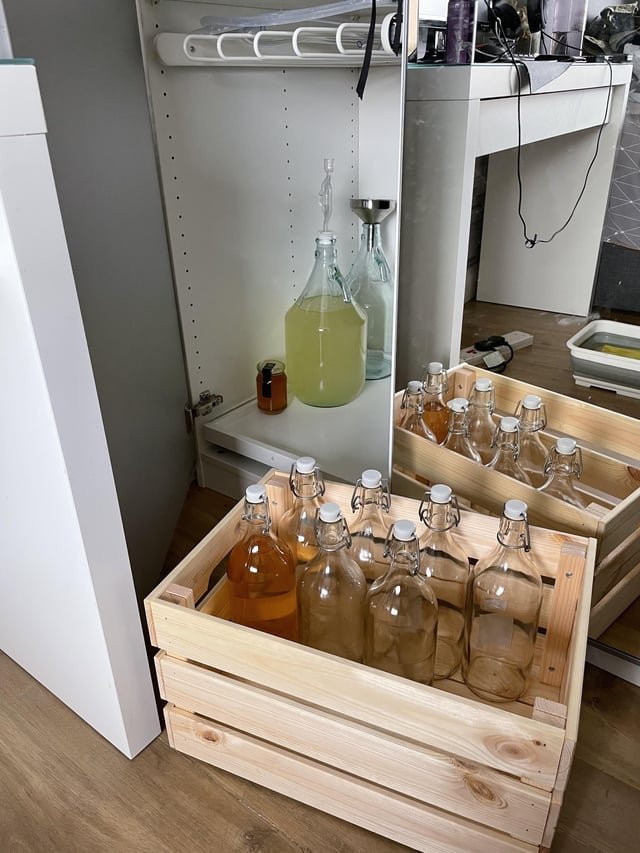
Guide: How To Stop Fermentation In Mead – Expert Tips
To stop fermentation in mead, cold crashing is a simple yet effective method. This process involves lowering the temperature of the mead to halt yeast activity. Once the desired sweetness level is reached, transfer the mead to a cold environment for a few days. This technique allows the yeast to settle, resulting in a stable, sweet mead ready for bottling.
How to Stop Fermentation in Mead
Welcome, mead enthusiasts! If you’ve ever found yourself in a sticky situation with an overly fermented batch of mead, fear not. In this comprehensive guide, we will delve into the art of stopping fermentation in mead, turning potential disaster into a sweet success. Whether you’re a seasoned mead maker or a curious beginner, understanding how to halt fermentation is a valuable skill to have in your brewing repertoire. So, grab your honey, yeast, and brewing equipment, and let’s dive into the wonderful world of mead-making!
The Science Behind Fermentation
Before we can discuss how to stop fermentation in mead, it’s essential to understand what fermentation is and how it occurs. Fermentation is a natural process where yeast converts sugars into alcohol and carbon dioxide. In the case of mead, yeast feeds on the honey, producing alcohol as a byproduct. This process is crucial for creating the delicious beverage we all know and love.
Knowing When to Stop Fermentation
While fermentation is an integral part of mead-making, there may come a time when you want to halt the process. Perhaps you’ve reached your desired level of sweetness, or you want to prevent the mead from becoming too dry. Whatever the reason, it’s important to know when and how to stop fermentation to achieve the perfect balance of flavors in your mead.
Monitoring the Fermentation Process
One of the key aspects of stopping fermentation is closely monitoring the process. By keeping an eye on the specific gravity of your mead using a hydrometer, you can track the sugar levels and alcohol content. When the desired sweetness has been reached, it’s time to consider stopping fermentation.
Testing for Sweetness
Another way to determine when to stop fermentation is by regularly tasting your mead. By sampling small amounts throughout the fermentation process, you can assess the sweetness levels and make informed decisions about when to intervene.
Methods to Stop Fermentation
Now that you understand the importance of monitoring fermentation, let’s explore some effective methods for stopping the process in its tracks. From cold crashing to using additives, there are several techniques you can employ to control the fermentation of your mead.
Cold Crashing
Cold crashing is a popular method for halting fermentation in mead. By lowering the temperature of the mead to near freezing, you can slow down the yeast activity significantly. This process causes the yeast to become dormant, effectively stopping fermentation and preserving the desired sweetness.
Adding Potassium Sorbate
Another way to prevent further fermentation is by adding potassium sorbate to your mead. This food-grade additive inhibits the reproduction of yeast, preventing them from fermenting any remaining sugars. However, it’s essential to follow the recommended dosage to avoid any off-flavors in your mead.
Back-Sweetening
If you’ve accidentally fermented your mead too dry, don’t worry! Back-sweetening is a technique where you add additional honey or sugar to your mead after fermentation has stopped. This method allows you to adjust the sweetness to your liking without restarting fermentation.
Best Practices for Stopping Fermentation
As you navigate the process of stopping fermentation in your mead, keep in mind these best practices to ensure a successful outcome:
Be Patient
Stopping fermentation takes time and careful consideration. Rushing the process can lead to off-flavors and inconsistencies in your mead. Take your time and allow the techniques to work their magic.
Document Your Process
Keeping detailed notes of your fermentation and stopping methods can help you replicate successful outcomes in the future. Note the specific gravity readings, ingredients used, and any adjustments made along the way.
Experiment and Have Fun
Exploring different ways to stop fermentation can lead to exciting discoveries in mead-making. Don’t be afraid to try new techniques and flavor combinations – after all, brewing mead is as much a science as it is an art!
With these tips and techniques in your brewing arsenal, you’re well on your way to mastering the art of stopping fermentation in mead. Remember, practice makes perfect, so don’t be discouraged by any setbacks along the way. Embrace the process, and soon you’ll be savoring your own delicious creations with confidence and pride. Cheers to your mead-making journey!
Six Ways to Halt Fermentation in Homebrew
Frequently Asked Questions
How can I halt fermentation in my mead?
To stop fermentation in mead, you can use potassium sorbate and potassium metabisulfite. These additives help prevent renewed fermentation by inhibiting the growth of yeast and bacteria. Add them to your mead according to the recommended dosage to effectively halt the fermentation process.
When should I consider stopping the fermentation process in my mead?
You may want to stop fermentation in your mead when it reaches your desired level of sweetness or alcohol content. It is crucial to monitor the fermentation process closely using a hydrometer to determine the right time to intervene and stop the yeast activity.
Can I stop fermentation in my mead naturally without using additives?
While it’s possible to let fermentation stop naturally on its own by reaching the yeast’s alcohol tolerance limit, it may leave the mead too dry or with residual sugars. Using additives like potassium sorbate and potassium metabisulfite provides a more controlled and reliable method to stop fermentation at the desired point.
Final Thoughts
To stop fermentation in mead, there are several ways you can use to stabilize your brew. One common method is to add potassium metabisulfite and potassium sorbate to inhibit yeast activity. You can also cold crash the mead by placing it in a refrigerator to halt fermentation. Another option is to pasteurize the mead by heating it to a specific temperature for a period of time. Experiment with these techniques to find the best method for stopping fermentation in your mead.


